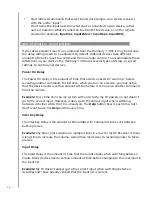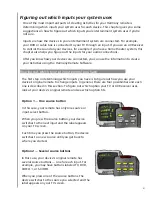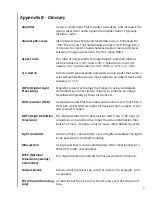
37
Appendix B - Glossary
Amplifier
Anamorphic views
Aspect ratio
A/V switch
DLP® (Digital Light
Processing)
DVD recorder (DVR)
HDTV (High Definition
Television)
Light controller
Mini-system
NTSC (National
Television System(s)
Committee)
Output Device
PAL (Phase Alternating
Line)
A stereo component that outputs to speakers, and increases the
gain or level of an audio signal. An amplifier doesn’t typically
include a radio.
Also referred to as Enhanced for Widescreen, or Enhanced for
16:9. The process that horizontally shrinks a 16:9 image into a
4:3 space to convert images between widescreen and typical
television image aspect ratio. Used on many DVDs.
The ratio of image width to image height. Common motion-
picture ratios are 1.85:1 and 2.35:1. Television screens are
usually 1.33:1 (also known as 4:3). HDTV is 1.78:1, or 16:9.
A device with several audio and video source inputs that sends a
selected audio/video source input signal to an output device like
speakers or a TV.
Projector screen technology that relies on using individually
controlled tiny mirrors (micro mirrors) to produce an image.
Developed originally by Texas Instruments.
A standalone unit that resembles and functions very much like a
VCR. Like a VCR, DVD recorders all have AV source inputs. It can
also record TV shows.
The high-resolution form of television. HDTV has 1125 lines of
resolution, or more than five times the video information than
that of a TV set, creating a much crisper, more detailed picture.
A device that is connected to a set of lights and allows the lights
to be powered or dimmed remotely.
A single unit that is some combination of the functionality of a
DVD, VCR, radio, and amplifier.
The standard video broadcast format used in North America.
A device that produces the sound or picture, for example, a TV
or speakers.
A video format that is used in the UK, and parts of Europe and
Asia.
Summary of Contents for Harmony 1100i
Page 1: ...User Manual Version 1 0 User Manual Version 1 1 i ...
Page 20: ...20 ...





































